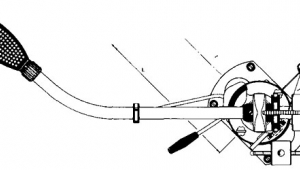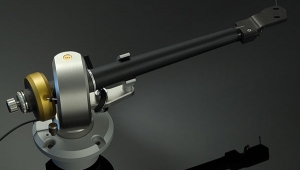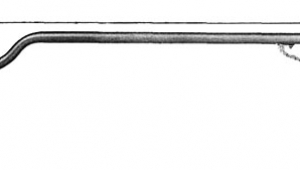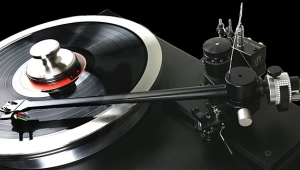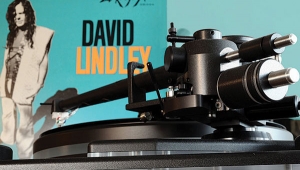| Columns Retired Columns & Blogs |
Graham Model 1.5 tonearm TJN Comments
Sidebar 2: TJN Comments
Footnote 2: I prefer the Stages on "normal," with the drapes behind them nearly open. DO closes the drapes and sets the Apogee tweeters on "high."—Thomas J. Norton
Thomas J. Norton auditioned the Graham arm mounted on an Oracle Delphi Mk.IV turntable in Aufust 1991 (Vol.14 No.8):
With almost any turntable other than the Oracle, a reviewer is really commenting on the sound of the turntable under review as partnered with his or her choice of arm and cartridge. The only approach has to be that of trying several different but limited combinations, then attempting the perilous leap from the particular to the general.
In any event, I felt I had a pretty good handle on the Delphi Mk.IV at this point—while remembering the realities observed in the previous paragraph. However, I still wanted to see how it compared with at least one other highly rated turntable. My first choice was the SOTA Cosmos, but unfortunately a new, Illinois-manufactured sample of that superb turntable had not yet arrived for an update to my Vol.13 No.7 review (footnote 1). The VPI HW19 Mk.IV with its new, heavier, TNT-like platter and updated line conditioner is directly price-competitive with the Oracle when the latter is used with its optional Turbo power supply; unfortunately, all the pieces of the VPI were not yet on hand for evaluation.
But when I glanced across the Stereophile listening room at Dick Olsher's equipment rack and espied the Australian Aura turntable with Graham tonearm in tow, I had an answer. A second Graham tonearm was in-house, awaiting my chance for a look-see-feel-hear. The Graham arm is a delight when it comes to changing cartridges; with one of them mounted on the Oracle, and the other on the Aura, it would be a simple matter to set up each cartridge to be used in separate Graham arm wands, tweak each cartridge in turn in each arm for tracking weight, azimuth, and VTA (overhang having been taken care of in mounting each cartridge in the wand), then switch back and forth between the turntables, using exactly the same cartridge and arm to make the comparison.
Two SME V arm-cables were on hand, and one was used in each Graham arm. Certain assumptions had to be made to keep the timing of the comparison reasonable. First, that the arm cables, each made from the same-type van den Hul cable, but manufactured at different times, were sonically identical. Second, that the VTA, even though set with some care, was close enough to avoid sonic differences due to small disparities in level. And third, that both Graham tonearms—identical except for the color (silver on the Oracle, gold on the Aura) were sonically the same.
But first it was time to get a feel for the sound of the Oracle with the Graham arm in place. I elected to start with the Dynavector cartridge, since I was quite familiar with it, and since it was the cartridge which I had been using most heavily with the SME V on the Oracle. My initial impressions were mixed. The combination was very detailed, clean, and tracked like a champ. But it was more than a bit lean-sounding after the SME. I actually had to check to make certain that DO had not left the Apogee tweeter setting on "high" after his last session (footnote 2). No, they were set to normal.
Was it merely a case of getting accustomed to the tighter, clearer midbass of the Graham after becoming used to the sound of the SME (which never, I must repeat, struck me as being unnaturally lush or full on the Oracle, especially with the Dynavector)? Or was it the Threshold S/550e amplifier which I had substituted into the system, sneaking an advanced listen for my long-delayed comparison of that amp with the same company's big monoblocks?
I do know that when I returned to the system after a couple weeks' hiatus for a short vacation followed by summer CES, my reaction was a mite more favorable. Whether it was a case of a fading memory of the sound of the system with the SME V, or the substitution of the Threshold SA/12e amplifiers, or a more fortunate choice of program material, I don't know—I suspect a mixture of the three (a more thorough comparison of the amplifiers is planned—stay tuned). But I do know that I was now more favorably impressed by the turntable/arm/cartridge combination. It remained open, detailed, and somewhat analytic in sound, from its tight low end to its sparkling top. I still would recommend caution when inserting this mix into a system already well endowed with either bright or clinical qualities, but I can't deny its crystalline clarity.—Thomas J. Norton
Footnote 1: Since it has both a new motor and a new owner and plant, an update of this unit would seem to be in order.—Thomas J. Norton
Footnote 2: I prefer the Stages on "normal," with the drapes behind them nearly open. DO closes the drapes and sets the Apogee tweeters on "high."—Thomas J. Norton
- Log in or register to post comments


